
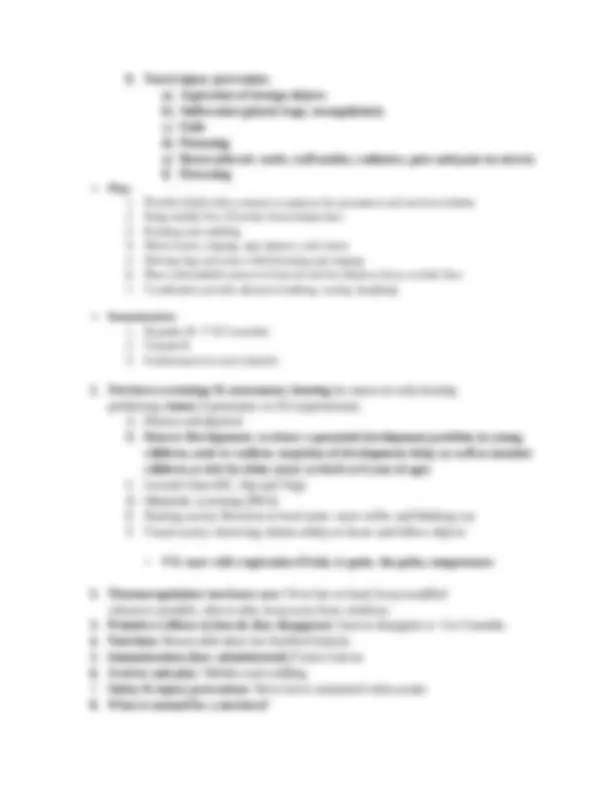
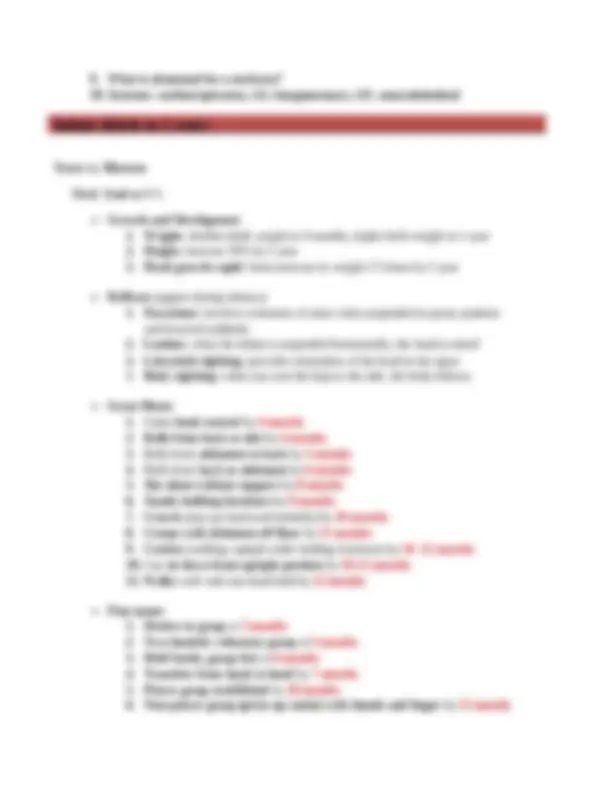
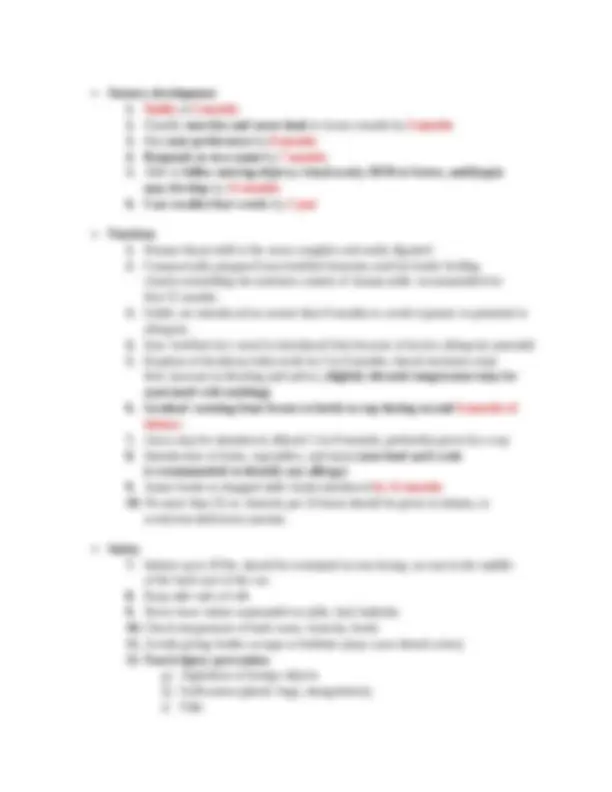
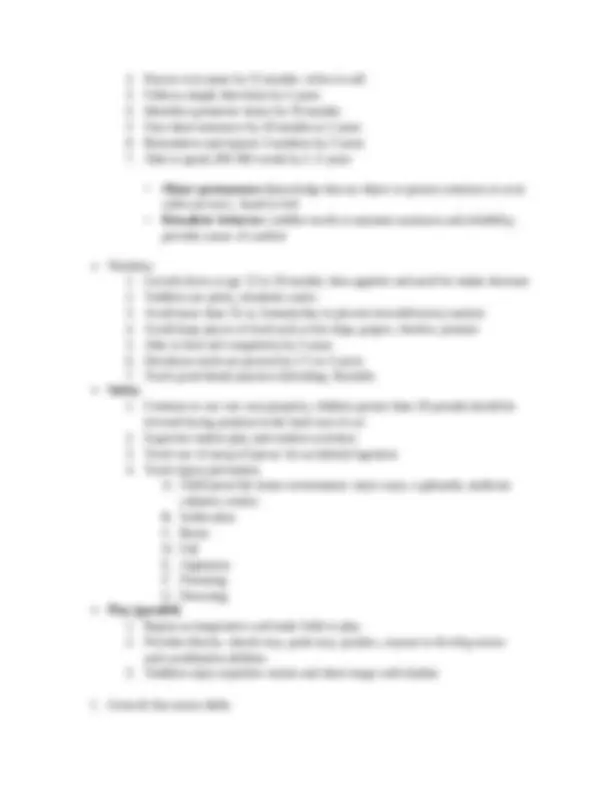
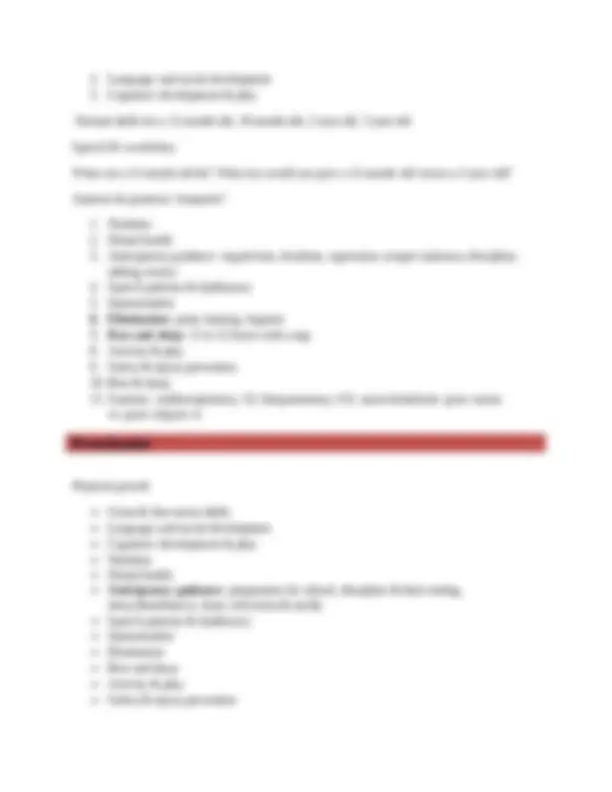
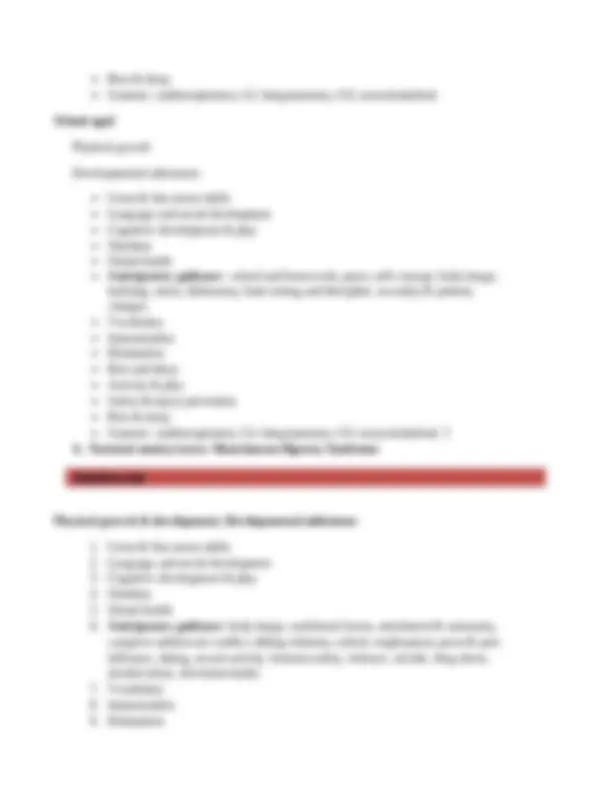


Study with the several resources on Docsity

Earn points by helping other students or get them with a premium plan


Prepare for your exams
Study with the several resources on Docsity

Earn points to download
Earn points by helping other students or get them with a premium plan
Community
Ask the community for help and clear up your study doubts
Discover the best universities in your country according to Docsity users
Free resources
Download our free guides on studying techniques, anxiety management strategies, and thesis advice from Docsity tutors
A detailed overview of human growth and development, covering key principles, developmental milestones, and important considerations for each stage of life. It includes information on physical, cognitive, social, and emotional development, as well as practical guidance for parents and caregivers. Organized by age group, starting with the newborn period and progressing through infancy, toddlerhood, preschool, school-age, and adolescence. It also includes sections on nutrition, immunization, safety, and common developmental concerns.
Typology: Study Guides, Projects, Research
1 / 11

This page cannot be seen from the preview
Don't miss anything!







Growth and development follow a specific pattern:
1. Cephalocaudal: (head to tail) the process by which development proceeds from head downward through the body towards the feet 2. Proximodistal: (near to far) the process by which development proceeds from the center of the body outward to the extremities. **3. *Know your milestones
Trust vs. Mistrust Oral Stage ➢ Growth and Development
1. General appearance: newborn’s head is one-quarter of the body length; the child is top heavy with short lower extremities. 2. Weight: 6 to 8 lbs. gains to 7 oz. weekly for the first 6 months 3. Height: 20 in.; grows 1 in. monthly for the first 6 months 4. Head circumference: 33 to 35 cm; head circumference is greater than chest circumference; posterior fontanel closes in 2 to 3 months and anterior fontanel closes by 12 to 18 months ➢ **Reflexes (present at birth)
2. Tonic Neck: elicited when side infant lies supine and head is turned to one side the infant will assume a “fencing position” and legs are opposite direction ( disappears by age 3-4 mos. ) 3. Gag, cough, blink, pupillary: protective reflexes ( persist throughout life ) 4. Grasp: the infant’s hands and feet will grasp when the hand or foot is stimulated. ( Palmar grasp lessens after age 3 mos. And plantar grasp lessens by 8 mos. of age ) 5. Rooting: elicited when side of mouth is touched, causing the child to turn to that side ( disappear at about 3-4 mos. but may persist for up to 12 mos .) 6. Babinski: fanning of the toes when sole of foot is stroked upward (disappears after age 1 yr.) ➢ Gross Motor: 1. Head Lag if prone on pillow, but able to move mon ➢ Fine Motor: 1. Hand predominantly closed at 1 month ➢ Sensory Development: 1. Hearing and touch well developed at birth ➢ Nutrition: 1. Breast Milk- best option for infant nutrition up to 1 year of age, micronutrients that are bioavailable (nutrients are available in quantities and qualities which makes it easy to digest as a newborn. Breast milk has a variety of immunologic properties that is found exclusively in human milk. Human milk has been shown to be affect to protect the newborn against respiratory tract infections and decreasing the incidence of hospital admission for respiratory tract illness, GI infections caused by enterococci, Otis media, allergies, atopy and type 2 diabetes 2. Formula (iron-fortified) closely resembles the nutritional content of human milk, recommended for the first 1st^ 6 months. No additional fluid required for the 1 st^4 months of life after 6 month fluoridated water can be given especially of breast feeding ends. Honey should be avoided in the first 6 months because of risk of botulism ➢ Safety: 1. Infants up to 20 lbs. should be restrained in rear-facing car seat in the middle of the back seat of the car. 2. Keep side rails of crib 3. Never leave infant unattended on table, bed, bathtubs 4. Check temperature of bath water, formula, foods 5. Avoids giving bottles at naps or bedtime (may cause dental caries)
**9. What is abnormal for a newborn?
Trust vs. Mistrust Oral- Anal at 1 ½ ➢ Growth and Development
1. Weight: doubles birth weight in 6 months; triples birth weight in 1 year 2. Height: increase 50% by 1 year 3. Head growth rapid: brain increase in weight 2.5 times by 1 year ➢ Reflexes (appear during infancy) 1. Parachute: involves extension of arms when suspended in prone position and lowered suddenly 2. Landau: when the infant is suspended horizontally, the head is raised 3. Labyrinth righting: provides orientation of the head in the space
➢ Sensory development
1. Smiles at 2 months 2. Usually searches and turns head to locate sounds by 2 months 3. Has taste preferences by **6 months
A. Anticipatory guidance- pacifiers, feeding problems, communication, colic, temperament, B. Safety & injury prevention, including car seats: Rear facing until 20 lbs. C. Play D. Growth pattern (pg .139) E. Nutrition: solids? Food safety? Introducing foods? F. Immunizations G. Dental health: start mouth hygiene as soon as tooth erupts, but 1 st^ dentist appointment at 2 years old H. Temperament-stranger vs separation anxiety I. Colic- recommendations to prevent shaken baby syndrome J. Systems: cardiorespiratory, GI, Integumentary, GU, musculoskeletal- assessing for hip dislocation
Trust vs. Mistrust (18 mos.-3 yrs.) Anal (potty training) ➢ Growth and Development:
➢ Rest & sleep ➢ Systems: cardiorespiratory, GI, Integumentary, GU, musculoskeletal School-aged Physical growth Developmental milestones ➢ Gross & fine motor skills ➢ Language and social development ➢ Cognitive development & play ➢ Nutrition ➢ Dental health ➢ Anticipatory guidance : school and homework, peers, self-concept, body image, bullying, stress, dishonesty, limit setting and discipline, sexuality & puberty changes ➢ Vocabulary ➢ Immunization ➢ Elimination ➢ Rest and sleep ➢ Activity & play ➢ Safety & injury prevention ➢ Rest & sleep ➢ Systems: cardiorespiratory, GI, Integumentary, GU, musculoskeletal 5 A. Parental anxiety/stress: Munchausen Biproxy Syndrome
Physical growth & development; Developmental milestones